|
The Brentford Branch
by Mikkel Kjartan
Introduction
Although the Great Western branchline is an immensely popular layout theme, most such layouts portray the bucolic, rural type of branch. However, the GWR also had a fair share of suburban branches, and in some of these there is much inspiration for a layout. One of my own favourites is the Brentford Branch, which served Brentford Town and Docks in what was then the outskirts of London.
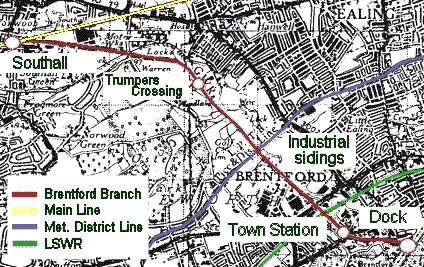
Overview of the Brentford Branch (1945 map)
Brief history
The branch extended from Southall on the main line to Brentford Docks on the River Thames, a total distance of some 4 miles. It was built by a nominally independent company, with Brunel as the engineer and financial backing from the GWR. The latter's main interest in the venture was to access the river-borne traffic at the waterhead where the Thames and Grand Union Canal met.
Construction of the line and docks began in 1855, initially as doubled broad gauge, with mixed gauge introduced from 1861. Full conversion to double standard gauge took place in 1876.
Passenger services on the branch lasted until 1942, after which the line continued as a goods-only branch until final closure in 1964.
Passenger and goods services
From the 1860s until the turn of the century, the branch was serviced by a dozen passenger trains each way daily. In 1904, these were replaced by a half-hourly railmotor service, taken over by a railcar in 1920. By 1929, passenger operation had declined to just a Workmens service, lasting until WWII.
Goods operation fared rather better, with much traffic moving back and forth between the main line and the large shipping shed in the docks. This included coal, steel, timber, pulp, flour, feedstuffs, cork, general merchandise and – in the 1950s – even Morris cars from Oxford!
A number of local lineside industries also generated traffic on the branch, including the Firestone rubber works, Quaker oats and a biscuit factory. And the Brentford Gas Company conveyed coke in daily block trains from Southall to the docks.
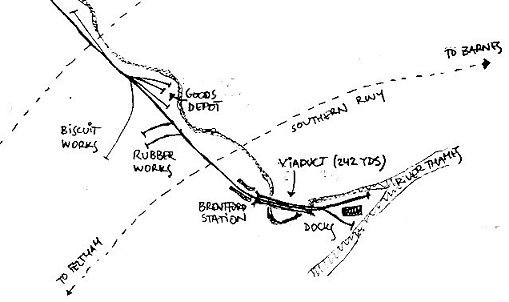
Main Sidings, Station and Dock (1947 map)
Layout potential
- One or more of the various works sidings would serve as an interesting setting for a minimum-space layout. For instance, to model one of the Firestone sidings all you need is a single point, a handful of grimy buildings and tanks, and a fiddle yard that serves as the main branch line (see map above).
- The passenger services might at first seem rather uninspiring, but that depends on your needs. In 1904, Trumpers Crossing Halt was opened South of Southall as the only stopping place other than Brentford itself. If you're looking for a simple and quick small-space layout, Trumpers Crossing is certainly an option. There is something fascinating about these tiny suburban halts, often located rather solitarily in the intermediate landscape of developing (yet not quite developed) suburbia. Throw in a railmotor or railcar and you can have a through station in a very small space.
- The dock itself also provides an obvious feature for modelling. If you have sufficient space, a most awesome and intriguing layout could be modelled, but there are also opportunities for us space-starved modellers: You could focus on just one or two of the dockside sidings, with a couple of barges along the quay and a crane to service them. If you're into structure modelling, the dock had a number of warehouses and of course the fascinating shipping shed, where trains and barges met beneath a large roof.
- Brentford Town station offers the rather unusual opportunity of modelling a station raised above the townscape. The station was located half a mile from the docks, in the built-up area where the line was raised on a viaduct to cross over various roads and the Grand Union Canal. If you like brick arches, girder bridges and an urban feel, there is good scope here. Whether or not one chooses to add a little more spice to passenger operation, the Workmen's services employed on the line provide an excellent excuse for running short trains of downgraded stock – perhaps in the austere but distinctive all-brown livery used on such services from the 1930s onwards.
- Apart from these more obvious possibilities, the line itself also had various detail features which could add something unusual to a layout. Most remarkable was perhaps Windmill Bridge, where the line crossed the Grand Union Canal and a road, all above one another. There's a diorama for you! Indeed, the presence of the Grand Union Canal provides a generally interesting aspect to the branch, with the two crossing each other at several points on the line, including two locations very close to each other between the station and docks.
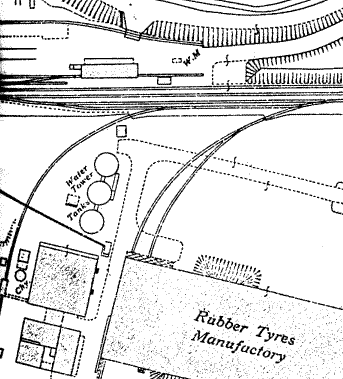
The Firestone sidings (1935 map)
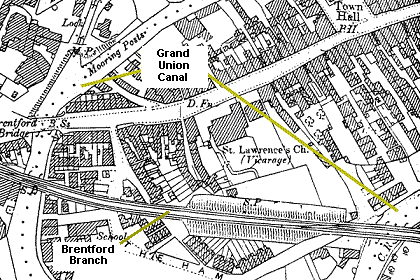
The Grand Union Canal (1895 map)
(Map illustrates two of the locations where the branch crossed the canal)
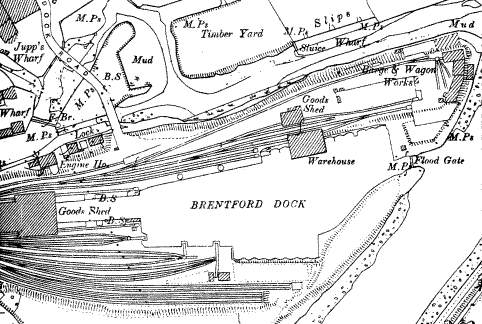
The Dock Area (1895 map)
Note: In 1919, the number of sidings was extended considerably
References
As far as I know, there are no books dedicated entirely to the Brentford Branch and docks, so if an actual prototype location is to be modelled, some independent research will be necessary. However, a number of broader publications have chapters or sections describing the branch. Those I know of include:
| "Branch Lines of West London" |
V. Mitchell & K. Smith, Middleton Press 2000 |
Includes a chapter on the branch with photos, maps and some basic info. The photos are mostly from BR times, but give a good impression of the atmosphere on the line, especially in the docks and (run-down) station. Also has a photo of Trumpers Crossing in early days. |
| "GWR Disused Stations in Greater London" |
J. E. Connor,
Connor & Butler 2000 |
I have not seen this book, but according to the list of contents it includes several sections on the Brentford branch, including both the docks and station. |
| "Great Western London Suburban Services" |
T.B. Peacock, Oakwood Press 1978 |
Has a brief description of the history of the Brentford Branch, but is especially useful as an all-round introduction to the origins and development of the GWR suburban system in the London area. The book is descriptive, with only a few photos. |
| "Brentford Dock and Branch" |
Article in: British Railways Illustrated Annual No. 3, Irwell Press 1994 |
Haven't seen this article, but it sounds promising. |
| Brentford Branch |
Railway Bylines Vol. 7 2001–2002, pp. 569 |
Not sure how extensive this item is, but the Railway Bylines articles are usually good stuff |
|




